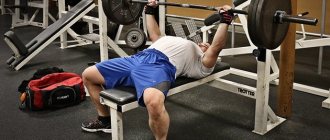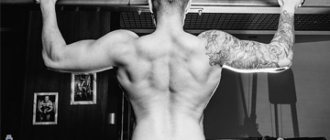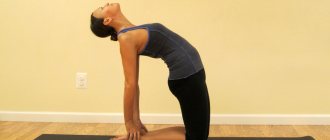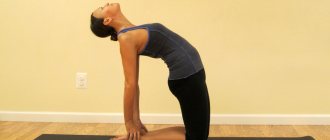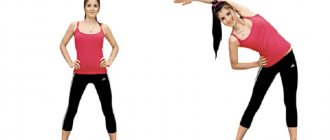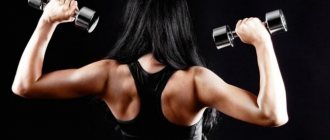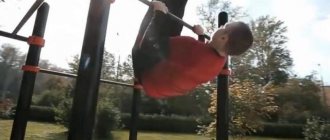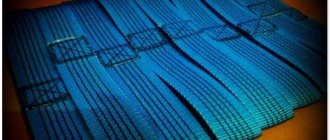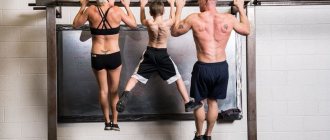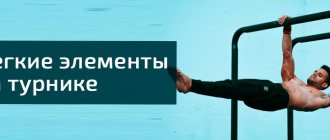Pull-ups are considered a basic exercise that engages the joints and muscles of the upper shoulder girdle and back.
It belongs to one of the highest classes in terms of difficulty of execution and is difficult for beginner athletes and girls. It is often replaced by the graviton training option, but it does not always allow you to work out all the zones that are included in the work when doing pull-ups on a classic horizontal bar. That is why, if you want to bring your back and upper shoulder girdle to perfection, it is worth studying the technique of doing pull-ups and mastering various types of this exercise.
What muscles are involved when doing a pull-up?
Pull-ups involve almost the entire shoulder girdle and back, including small muscle groups that remain in a relaxed state during other types of loads.
This exercise is used to train the following muscle groups:
- targeted: latissimus dorsi muscles;
- synergizing: include the biceps, brachioradialis and brachialis muscles, teres major and minor, infraspinatus, middle and lower trapezius muscles, pectoralis minor, rhomboids, posterior deltoid, and levator scapulae;
- stabilizing: long head of the triceps.
Thus, it turns out that pull-ups that are ordinary at first glance can improve the growth of muscles throughout the upper body, chest, back, and arms.
Adviсe
Warming up
Before any workout, and especially before a strength exercise, muscles and joints must be prepared for heavy loads. Specifically, pull-ups require warming up the shoulder girdle.
For beginners
For those who, due to lack of strength, can barely perform one pull-up or none at all, affordable Australian pull-ups will help.
Benefits of Pull-Ups
Pull-ups have many advantages over alternative exercises for the upper shoulder girdle. The most important of them is the absolute undemandingness of equipment. All the athlete needs is a bar fixed just above his height. Using various variations of pull-ups, you can work out various muscle groups well and sculpt the relief of the upper shoulder girdle, back and chest, based on personal preferences and goals.
With pull-ups you can:
- give the top part a V-shape;
- achieve good back relief;
- develop the muscles of the upper back and shoulder girdle to the maximum;
- develop grip strength;
- improve weight performance when performing back exercises;
- increase the production of growth hormone and achieve excellent results in a shorter period of time;
- increase energy consumption, which will lead to weight loss.
Among other things, pull-ups differ from other exercises in their high degree of variation. Using different grips, you can work different muscle groups to achieve perfect mass and shape.
Correct technique for pull-ups on the horizontal bar
We suggest you master pull-ups with a medium reverse grip - this is a basic version of the exercise for beginners.
Grasp the horizontal bar with a reverse grip, placing your palms shoulder-width apart. Hang on the horizontal bar, relaxing your lower body and feeling the muscles in your back and arms working. As you exhale, bend your elbows, work the muscles of your arms, back and chest and pull your body up. Don't slouch, don't throw your head back, try to keep your body straight.
Touch the bar with your chest, then smoothly lower your body down.
Where should a beginner start to learn how to do pull-ups?
Rarely does anyone succeed in doing pull-ups the first time, so it is important for beginners not to force their body with excessive muscle tension. Unsuccessful, exhausting attempts to pull your chin up to the bar the first time in 99% of cases result in microtraumas, so you should give preference to a set of preparatory exercises.
First you need to master the technique of “negative repetitions”. The essence of this exercise is to assume a position as if the pull-up has already been completed and the body returns to its original position. To do this, you will need a horizontal bar and a low support (bench, stool, etc.). The main thing is that its height is just enough so that the athlete, standing on it, can calmly reach the horizontal bar with his chin.
The technique for performing negative repetitions is as follows:
- Starting position - standing on a chair, chin at the level of the horizontal bar, arms bent at the elbows and fixed at an average distance from each other on the bar.
- Next, the legs are bent so that the arms tense, holding the body in its original position.
- The arms are slowly straightened, as when coming out of a pull-up.
- Then the athlete returns to the starting position. If necessary, you can help yourself with your legs (lean them on a support) or ask an assistant to lift you from behind.
You shouldn’t overload yourself right away; 3 sets of 5 repetitions will be enough. It is not recommended to accelerate or sway while straightening your arms. All movements should be as smooth as possible.
Before starting training with pull-ups, it is advisable to warm up the muscles well and stimulate the cardiovascular system with a warm-up. But even here you should be restrained so as not to start the main training feeling tired.
Pull-ups with elastic band
The next step is to use a fitness band. Let's take it and secure it to the crossbar so that one edge hangs down. If the elastic band is long, then we stand on it with our feet, if it’s shorter, then we stand on it with our knees. Next, we begin to pull ourselves up to the bar. Due to the resistance, the elastic band will push us to the top, which will simplify our task. I think there is no need to describe the execution technique, since I already spoke about pull-ups at the very beginning of the article. The main thing is not to sway from side to side. Work along a level path.
I suggest you also watch the video, it lasts 20 minutes. In it, Chris Heria clearly explains how to learn to do pull-ups:
Pull-ups in the gravitron
The Gravitron is a multifunctional simulator designed to train many muscle groups. But we will consider it only from the point of view of pull-ups. The whole secret lies in the movable platform, which acts like an elastic band. Pushing our body up. To do this, we need to set the weight we need. For a beginner, it is recommended to use 70% of your own weight, and experiment with it as you train. So if you don’t have elastic bands in your fitness room and don’t want to buy them. Then feel free to switch to graviton. But for me, it’s better to use all 4 options.
Pull-up technique
Before starting training on the horizontal bar, you need to familiarize yourself with the recommendations of experienced bodybuilders and their mentors on how to do pull-ups correctly:
- you cannot involve anything other than the muscles of the back, arms and chest in the process of lifting the body;
- to avoid injuries, there is no need to accompany the pull-up with jerks and sudden movements;
- the body must be in a strictly vertical position during ascent and descent;
- rises are performed while exhaling, and you need to lower while inhaling.
Otherwise, the technique for performing pull-ups varies depending on what type of exercise is performed.
Common Mistakes
Amplitude
By not completing an exercise completely, the workout may lose half of its potential. Only full extension and maximum lift will bring good results, even if you perform a small number of repetitions.
Jerks
The movement should be done only with the help of force; no amount of jerking and swinging can give a good workout to the muscles.
Irregular movements
In order not to develop deviations in any direction, try to ensure that the load on the muscles falls evenly.
Straight Grip Pull-Up
Straight Grip Pull-Up
It is advisable to start mastering pull-ups on the horizontal bar as such with a direct grip. It is simpler to perform, but in different variations it helps to work out the entire upper shoulder girdle and back.
The technique for performing pull-ups with a straight grip may differ depending on the grip width:
- when doing pull-ups with a classic grip (medium), the lift is made to the level of the chin - at the peak point it should be slightly above the crossbar, the gaze is directed forward;
- when pulling up with a narrow grip, the body is lifted until the bar is at chest level, and the gaze is directed to the hands;
- When performing pull-ups with a wide grip, the chest (its middle part) should be located in the upper peak at the level of the horizontal bar; the maximum load falls on the latissimus dorsi muscles.
There is an opinion that the greater effect of pull-ups using a direct grip is achieved with a high lift of the body - at the peak at the level of the crossbar, the midline of the chest or at least its upper part is located. At the same time, the back bends slightly in the lower back, and the head is thrown back.
When performing pull-ups with a wide and medium grip behind the head, you need to stretch until the level of the crossbar coincides with the top line of the body (just above the clavicle bones). It is important not to make sudden jerks, but to keep your back straight. You can tilt your head slightly forward so as not to injure the back of your head while lifting.
Recommendations and tips
While you are pulling yourself up to the horizontal bar, do not strain your biceps. The only task of your hands at this moment is to hold the bar firmly, without allowing your body to sway.
The wider the grip, the more convenient it is to train. Due to the fact that the visual width of the back is determined by the upper part of the lats, in order to pump them up, the grip should be made wider. With a narrower palm position, the load is focused on the lower part of the latissimus and pectoral muscles.
In order not to reduce the amplitude of contraction of the lats, keep your elbows in the correct position, do not bring them closer to the body, keep your chin slightly higher than the horizontal bar.
Beginners are advised to seek the help of a trainer or other partner who will help pull the body towards the bar until the head is at the desired level.
Rear grip pull-ups
Rear grip pull-ups
The reverse grip is good for working the biceps and back muscles. The closer the hands are placed to each other, the more the biceps are involved. Otherwise, the technique is similar to performing pull-ups with a direct grip:
- the hands are located at a selected distance from each other;
- During lifting, the back is straight, slightly arched in the lower back;
- the head is slightly thrown back;
- movements are smooth, without jerks or distortions.
You can pull yourself up to the level of your chin or to the middle of your chest. Here the goal of the training plays a role: if you plan to load your arms as much as possible, pull yourself up to the chin, and if there is a need to pump up your back muscles, pull yourself up to your chest.
How to learn to do pull-ups from scratch at home?
The lesson looks like this:
- Stand on a chair.
- Grab the bar with an overhand grip (hands shoulder-width apart, palms facing outward).
- Hold for a few seconds without supporting yourself on a chair so that your chin is slightly higher than the horizontal bar.
- Slowly straighten up until you hang on straight arms.
13 Mar
2022 Interesting materials:
Is it possible to export shells? Is it possible to pick up the Inn later than the appointed time? Is it possible to claim a social deduction for the costs of training at a driving school? Is it possible to close an electronic sick leave in another clinic? Is it possible to replace sugar with fructose in baking? Can kimchi be frozen? Can I freeze chopped fresh cabbage? Is it possible to freeze champignons in the freezer? Can you freeze Chinese cabbage? Is it possible to freeze canned champignons?
Parallel pull-ups
Parallel pull-ups are no different in technique from the previous versions, with the exception of the position of the scapular bones. In the upper peak position, you should bring your shoulder blades together as much as possible, and your elbows should be slightly pulled back. The back is in the same position as in the previous versions - slightly arched in the lower back, without lateral distortions.
The effect is also repeated: with a narrow grip, when the hands are located close to each other, the biceps and chest muscles are maximally used, and with a wide grip, the latissimus dorsi muscles work more actively.
Pulling up the Gironde
This method is suitable only for experienced athletes with good strength training, as it has a greater range of motion compared to previous techniques. Pull-ups are performed with a forward or reverse grip. Hands at an arbitrary distance from each other.
Technique:
- Dead hang at the bottom with a neutral (medium) grip.
- Rhythmic pull-up to the middle of the chest.
- Quick return to starting position.
Ideally, there should be no delays between the upper and lower peaks. The intensity and amplitude of movement are maximum, resulting in more active training of the upper shoulder girdle and back.
Head pull-ups
Pull-up by the head
This method of pulling up is more difficult to perform, as it combines the classic exercise with pulling up by the head.
The technique is as follows:
- Hands on the bar are placed slightly wider than shoulders, legs are crossed and bent at the knees.
- A classic pull-up is performed up to the chest. Then the body returns to its original position, the arms are completely relaxed and straightened.
- A pull-up is performed with the hands behind the head. Return to original position.
Alternating between classic pull-ups and behind-the-head pull-ups helps work out the maximum number of muscles.
Types of pull-ups
There are a large number of variations of pull-ups on the bar. They differ from each other according to some criteria:
- Grip width:
narrow, medium or wide. - Grip options:
regular, reverse and parallel. - Area of contact of the bar:
to the chest behind the head. - Body position:
vertical and horizontal.
All of these changes will load different parts of the lats from top to bottom, and will also increase or decrease the range of motion.
Pull-ups to the chest, wide and medium grip
This is the most common type of pull-up both in the gym and outside of it. The chest pull uses a lot of muscles besides your back. Then why should we do it? Everything is very simple. This exercise without the correct technique and focused attention on the desired muscle group, and for us it is the back, will not bring any results. In order to achieve switching on and off of a particular muscle, grip width comes to our aid.
Medium grip
This is a more classic option. That is, we place our hands slightly shoulder width apart. This is where beginners should start in order to become familiar with the exercise technique and strengthen their back muscles. Pull-ups with medium grips involve many secondary muscles: biceps, trapezius. Therefore it is easier to do.
Wide grip
But this is the so-called “professional grip”. Of course, this is all conditional. We place our hands at such a distance that when we pull ourselves up, our forearms are perpendicular to the bar. This will be the so-called wide grip. These pull-ups are a more isolated version. That is, the trapezius and biceps are turned off from work, and the entire load goes to the latissimus muscles. For a beginner, this option will be more difficult, but with a little work with the average position of the hands, you can easily master it. Also, do not forget the point that the wider the grip, the smaller the amplitude of movement. On the one hand, why do we need it if the load is already directed to the target muscle. I won’t argue about what amplitude is. For me personally, full amplitude works better than partial.
Of course, there is no universal advice that would suit every athlete without exception. The only sure way is to try each of the grips and choose the one that meets all your needs, namely growth and strength of the lat muscles.
Execution technique
- Grasp the bar with your preferred grip.
- Scroll down. Slightly arch your back at the lower back.
- Bend your legs at the knees; if uncomfortable, leave them extended.
- As you exhale, pull yourself up to the bar. There is no need to try to touch it with your chest; it will be enough to level it with your chin.
- Pause briefly and squeeze your lats as hard as possible.
- As you inhale, lower yourself to the starting position, straightening your arms completely at the elbow joint.
It is important to remember one point. Your task is not to bend your arms at the elbow joint, but to bring your elbows towards your body. It is this movement that will engage the lats, not the biceps.
Reverse grip pull-ups
This type of pull-up is rumored to be much easier to perform. This is because in childhood, when boys grabbed the bar with this grip, all their peers started shouting: “Ugh, you pull yourself up like a girl.” And in the world it is so customary that the female sex is considered physically weaker. And this expression has taken root in us. But no one wondered why it was easier? Yes, all because the biceps are more predisposed to perform this movement. And the reverse grip allows you to use its potential to the maximum. It was with the help of bending our arms that we did pull-ups in childhood. But I have already said that our task is to work on the lats, and for them such a grip is one of the most difficult. For a professional athlete, this type of pull-up will help develop the lower sections of the latissimus muscles and will not be a big problem in the execution technique. But beginners will have to sweat before they can feel their back. Therefore, at the beginning of your journey, it is better to pull yourself up with an easier option. What a turn! The simplest pull-ups turned into complex ones. The grip width is generally used to be slightly wider than shoulder width.
Execution technique
The principle of implementation here is the same as the option above. There are just some points you need to know.
- We will have a reverse grip (we take the crossbar from below with our hands)
- You need to pull until the bar touches the middle of your chest.
- We lower our elbows along the body
- When lifting up, move your shoulders back; when lowering your body, move your shoulders forward.
Before you say that this is an exercise for weaklings, try it in action, and then draw conclusions.
Head pull-ups
So we get to the favorite of many bodybuilders, these are pull-ups by the head. When performing this exercise, the upper part of the lat is actively involved in the work. As well as the teres major, teres minor and posterior deltoids. This option is very technically complex and is 100% not suitable for beginners. The grip is used wide so that there is no breaking load on the shoulders.
Execution technique
The technique itself is the same as other options. But there are some features:
- Your back should be straight
throughout the entire exercise. Legs are bent, knees point straight down. In order to achieve this, you will need to bring your shoulder blades as close as possible to each other. Pull your shoulders back and turn them out as much as possible.
- Of course, this increases the chance of injuring your shoulder, so you need to be extremely careful!
- No sudden movements. As you exhale, gently pull your torso toward the bar, trying to bring your elbows toward your torso as much as possible. While inhaling, we return to the starting position.
If you are unable to keep your back straight while performing this exercise. It’s better to give it up completely. So at least you won’t injure yourself!
Parallel grip pull-up
This type of pull-up is performed on a special bar. Fortunately, now almost all halls are equipped with it. If you are not one of those lucky ones, then you will need to add a little ingenuity. You can take a V-shaped handle for pulling the lower block to the belt and place it on the bar with the handles down. Then your grip will also be parallel, that is, your palms are facing each other. Pull-ups with such grips involve many muscle groups: the latissimus (especially the lower sections), the teres major and minor, a little biceps (with the correct technique) and deltoids. Also, a secondary load goes to the trapezoid and diamond-shaped muscles. As for the range of motion, in this exercise it will be maximum. In the field of bodybuilding, according to the prevailing opinion, this option is more used as a secondary option (clogging). But personally, in parallel grip pull-ups I feel how the lats work better than in all the others. Therefore, before burying this exercise, I advise you to try it in practice.
Execution technique
This option is a kind of analogue of pull-ups with a reverse grip. The technique is almost the same. That is:
- We will pull our torso until our chest touches the bar.
- Elbows move along the body
- When lifting, move your elbows back, when lowering, bring them forward a little
- As you exhale, pull your body up, and as you inhale, return to the starting position.
- We use a parallel grip with a narrow hand position
Remember, if you want to achieve significant results in pull-ups, then work on your technique.
These are all of the most popular pull-ups used in bodybuilding.
Pull-ups with a narrow opposite grip
Pull-ups with a narrow opposite grip
The technique resembles a pull-up with a parallel grip, but the difference is that the athlete holds on to a regular horizontal bar, that is, the hands are not just located towards each other, but are on the same line. The value of this exercise is a deeper development of the shoulder and brachioradialis muscles, as well as the biceps. The muscles of the buttocks and abs are involved.
Technique:
- The athlete hangs under the horizontal bar perpendicular to its direction. The hands are brought together.
- The pull-up begins slowly, as the head approaches the horizontal bar, it is moved to the side, the shoulder touches the horizontal bar.
- Return to hang.
- The pull-up is the same as the previous one, but this time the head is moved in the other direction.
- Return to original position.
Pull-ups are done by tensioning only one arm, the second is used to hold the body in an upright position.
Training program
Having discussed the types of pull-ups on the horizontal bar and the muscle groups that are involved in them, let's talk a little about the training program that allows you to achieve success. Before you start training, you need to determine your maximum in a particular type of pull-up. Then you need to see which group you belong to and perform the specified complex at least twice a week. After a month, you need to test your capabilities again and, if you gain strength, move on to the next level of difficulty.
Half-Moon or one-arm pull-up
This pull-up is practiced in preparation for one-arm pull-ups. A neutral grip or pronation is suitable for this exercise.
Starting position: hanging with arms straight and relaxed. The body is pulled up only on the right or only on the left hand. The second one is “stretched” at this time, as a result of which the line of the arms and shoulders forms a “half moon”. After mastering this type of pull-up, you can move on to one-arm pull-ups.
Narrow overhand grip
It's time to consider the types of pull-ups on the horizontal bar with a narrow grip. Let's start with an overhand grip. This version of the exercise is well suited for people suffering from insufficient mobility of the wrist joints. It works the lower lats, serratus and to some extent the shoulder muscles well.
You need to grab the bar with as narrow a grip as possible (so that your thumbs are almost touching). Bending in your back, you need to pull up, trying to touch the lower chest to the projectile.
Secrets and subtleties of pull-ups
Even those who easily perform several sets of various pull-ups do not always know 100% of the facts about this exercise. The most popular questions that can be heard from experienced and beginner athletes concern the range of motion, the most effective type of grip, the height of the body lift and much more.
Up to the chest or up to the chin?
The most popular question concerns the difference between chin-up and chest pull-ups. Famous coaches and athletes recommend practicing pull-ups up to the chin using a reverse grip, and pull-ups up to the chest in combination with a straight grip. With this combination, the risk of injury is significantly lower, which is especially important for novice athletes. In general, pull-ups to the chest are more effective in terms of pumping up the back muscles, while pull-ups to the chin allow you to better work the muscles of the upper shoulder girdle and arms. Pull-ups that are too high can be dangerous because lifting your chest above the bar will place maximum stress on the muscles between your shoulder blades, which can lead to injury.
Weighting - when is it necessary?
Using extra weight when doing pull-ups can be beneficial or harmful depending on several factors:
- mastery of pull-up techniques - if there is the slightest doubt that you are doing everything correctly, it is better not to use weights;
- condition of the back and spine - if there is a tendency to injury or problems with the spine, it is better not to use aggravation;
- if you are overweight (more than 13 kg), the burden will be unnecessary.
In general, experienced athletes who have ideally mastered the exercise technique resort to using additional weight when doing pull-ups.
Ideal amplitude - what is it?
Pull-ups “to the maximum” will benefit those who have already achieved certain results and are fluent in the pull-up technique. Discomfort and acute pain in muscles and joints should be a signal to stop training.
A small amplitude is more effective and less dangerous if training on the bar is intense and/or with additional weights. Exercises in this mode do not harm the joints and stimulate maximum muscle growth. However, it is worth remembering that severe restriction of movement and minimal range of motion will not lead to the goal of muscle growth and increased strength. Everything should be in moderation.
It is important to remember that the concept of ideal amplitude when doing pull-ups is as individual as food preferences. The athlete must listen carefully to his muscles to understand in what range of movements is best.
The “swinging” technique – to use or not?
Attempts to show a good quantitative result through the deceptive “swinging” technique leads to loosening of the joints, and has minimal effect on the muscles. By using it, a beginner risks never achieving significant results. Moreover, failure to comply with the pull-up technique often leads to injuries that imply a ban on any load. It is better to do fewer repetitions, but with high quality, than to waste time and joints, deceiving the body with the laws of inertia.
Which grip should you choose?
The main rule is that the grip should be tight. The width and direction depend on the training goal. If you plan to pump up your arms and shoulders, a narrow or medium reverse grip is suitable. For high-quality back work, a combination of wide and straight grips is ideal.
Without pulling up, it is impossible to create an ideal athletic body with a V-shaped back and chest. To master this seemingly simple way to increase mass and strength, you will have to spend several months. But it's worth it - your body will become really strong and beautiful. The main thing is to carefully study the technique of performing various types of pull-ups and systematically train to achieve your goals.
